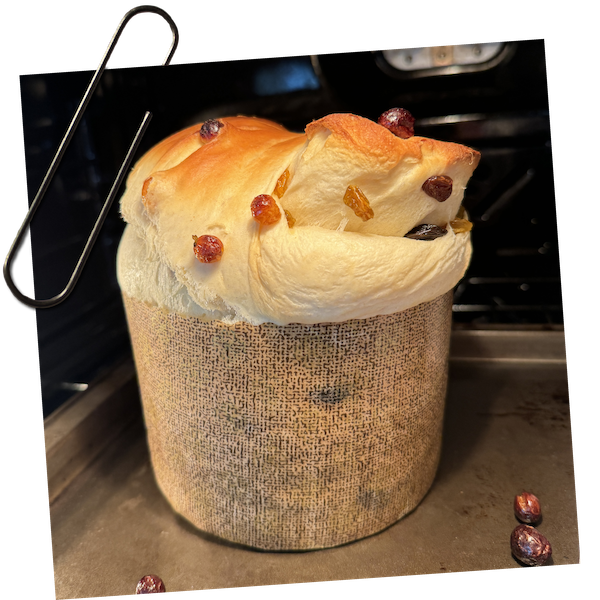
Orthodox Easter Kulich (Paskha), a cherished tradition, is a tall, cylindrical sweet bread that symbolizes the resurrection of Christ. Decorated with icing and often adorned with colorful sprinkles or candied fruits, it boasts a soft, fluffy texture and a delightful aroma of spices like cardamom and vanilla. This iconic treat holds a special place in Easter celebrations, embodying the spirit of renewal and joy.
| Ready in 5-7 hours | Serves 6-8 people |
| Yield 2x 600g | Metrics: US, EU |
Ingredients
Sweet Stiff Starter
- 90g bread flour
- 40g water
- 45g active liquid sourdough starter
- 9g sugar
Sponge
- 200g warm milk
- 100g sugar
- 100g bread flour
- 7g dry instant yeast
Main Dough
- 160g sweet stiff starter
- 2 eggs
- 3 yolks
- 100g sugar
- 45g sour cream
- 500g bread flour
- 100g soft butter
- 30g oil without flavor
- 12g salt
- Spices (cinnamon, cloves, nutmeg)
Orange Sparead
- 60g butter
- 1tbs orange paste
- 150g Raisins soaked in warm water or rum
Cream Cheese Spread
4 ounces cream cheese
80g sugar
1 egg yolk
Directions
Sweet Stiff Starter
- 6 am dissolve sugar in the water, add liquid sourdough starter on its peak and whisk together, add flour, mix well, form a ball, place in jar, cover let ferment at room temp 30C/86F for 3-4 hours until it increases in volume in 2 or more times.
Stiff sweet starter will have lower hydration than regular liquid starter and will help us to lower the acidity of final product (learn how to make sourdough starter from scratch here).
Sponge
- 10 am, in a mixing bowl, combine warm milk, sugar, yeast, and flour. Place the sponge to ferment for 1 hour at 30-32°C/86-89°F until the mixture becomes foamy.
Dough
- 11 am to the sponge mixture, add eggs, egg yolks, sour cream, sugar, sweet stiff starter, and flour. Use the paddle attachment of your mixer. Start kneading on low speed for 3 minutes, then increase the speed to medium and continue mixing for 12-15 minutes. Stop periodically to clear the sides of the bowl. The dough should become stronger and come together.Add butter and continue kneading on medium speed for 12-15 minutes. When the dough wraps around the paddle, add oil and knead until the dough is strong. Perform a windowpane test.








- Form the dough into a ball, cover it, and let it ferment at 30-32°C/86-89°F for 2 hours. During this time, you should start seeing signs of fermentation (the dough will become lighter and puffier).
- Note: At this point, you can continue with following steps, or you can refrigerate the dough overnight, and start with shaping next day.
- Meanwhile, prepare the orange and cream cheese spread by mixing all ingredients together, leaving the raisins aside.




- 1 pm Sprinkle the work surface with flour, then divide the dough into 2 equal portions (about 600g each). Roll each portion into a rectangle with sides measuring 20x40cm/8×16 inches.
- Spread the prepared spread all over the surface and sprinkle with raisins. Roll each piece of dough into a tight roll.





- Using a sharp knife, cut each roll in the middle lengthwise, leaving one edge uncut.
- Take one part and start rolling it into a circle, then repeat with the second part of the dough.Place one circle on top of the other, tucking any uneven edges to create a round Kulich.




- Transfer the Kulich into a mold. I’m using paper molds for 750g of dough.
- Let it proof for 3-5 hours at 30°C/86°F until it doubles or more in volume.
- Preheat the oven to 350°F. Place the Kulichi into the oven, lower the temperature to 320°F and bake for 20 minutes, then increase the temperature to 330°F and bake for an additional 25-30 minutes. Internal temperature should reach 97°C/206°F.




- If the top starts browning too quickly, halfway through baking, open the oven and cover the top of the Kulich with foil. Then, close the oven and continue baking.
- At the end of baking, check the internal temperature of the Kulich. It should be 97°-98°C/206°-210°F.
- Remove the Kulich from the oven and let it cool down. Sprinkle powdered sugar on top.






Enjoy!
Disclosure: As an Amazon Associate I earn from qualifying purchases.
I musr try. Thank you for sharing.
You’re welcome! We’re glad you found the information helpful. Let us know if you have any other questions or need further assistance. Happy exploring!
Would it work without instant yeast? Thank you!
Yes, but it will take so mauch longer to proof.
Do you add 12 g salt with flour together?
yes )
Não tem como colocar a opção de traduzir para o português?
Hi Natasha, I have Italian lievito madre (stiff sourdough around 44% hydration). How can I modify the recipe since it calls for liquid sourdough? Thanks!!!
JC
Thank you for this amazing recipe. I just made them for the first time and they were deliiiiiicious! Sooo good and fluffy!